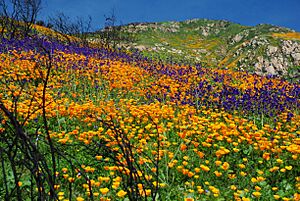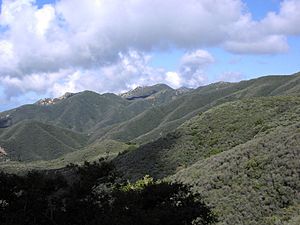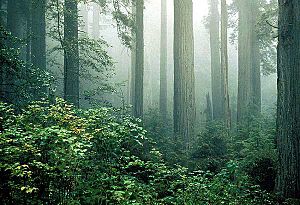Ecology of California facts for kids
The ecology of California is all about how living things like plants and animals connect with their surroundings in this amazing state. California is huge and has many different types of land, from hot deserts to tall mountains and cool coastlines. Because of this, it's home to a huge variety of plants and animals, each living in a special "neighborhood" called an ecoregion.
Scientists often divide California into four main types of ecoregions:
- Dry deserts
- Warm Mediterranean areas
- Cool, forested mountains
- Misty coastal forests
These different areas have their own unique groups of plants and animals that are perfectly suited to live there.
California's Deserts
California has some big deserts in its eastern parts. This is because tall mountains block most of the rain from reaching these areas. Imagine a giant wall stopping the clouds!
The southeastern part of California is home to the Sonoran desert. This desert also stretches into Arizona and Mexico. California also has two "high deserts": the Mojave desert and the Great Basin Desert. If you visit the Mojave, you'll see lots of cool Joshua trees. They are a special sign of this desert!
These deserts usually get only about 2 to 10 inches (50 to 250 mm) of rain each year. The plants here are tough and can live with very little water. You might see creosote bushes, sagebrush, and saltbush. In higher, slightly wetter spots, you can find drought-resistant trees like pinyon pines.
Mediterranean Areas
The coast of California, from Monterey Bay down to the Mexican border, and inland towards the Sierra Nevada mountains, has a special climate called "Mediterranean." This means it has warm, dry summers and mild, wet winters.
This region is famous for its "chaparral" areas. Chaparral is a type of scrubland with tough, woody shrubs. There are different kinds of chaparral depending on where you are:
- Coastal Chaparral: This is found along the coast, stretching into Baja California. It's amazing because it has the most types of native bees in the United States!
- Mountain Chaparral: You'll find this in mountain ranges like the Transverse Ranges. It's a mix of sage scrub, chaparral, and mountain plants.
- Interior Chaparral: This forms a ring around California's Central Valley, including the hills near the Bay Area. Some plants here are very unique because they grow in special soil types.
These areas have many different plant groups, like oak woodlands and coastal grasslands. Wildfires are common here, and many plants have adapted to grow back after a fire.
California's Central Valley used to be a huge grassland with tall native grasses. Animals like grizzly bears, gray wolfs, and tule elk once roamed here. Today, much of this grassland has been turned into farms and ranches. However, places like the Carrizo Plain still preserve the native grass, earning it the nickname "Serengeti of California."

Forested Mountains

The cooler, wetter mountains in California are covered in thick forests. The main mountain ranges with forests are the Sierra Nevada, the Klamath Mountains, and the Eastern Cascades.
The Sierra Nevada mountains are incredibly rich in plant life, with hundreds of plant species found nowhere else in the world! As you go higher up the mountains, the plants change because the climate gets colder and harsher. You'll see different types of conifer trees like Jeffrey pines and Lodgepole pines. Even higher up, it gets too cold for trees, and you find alpine tundra with small, tough plants. The Sierra Nevada is also famous for its giant sequoia trees, which are the most massive trees on Earth!
The Klamath and Siskiyou Mountains are a special place for biodiversity, meaning they have a huge variety of living things. This area is one of the most diverse temperate forests in the world! Its unique location and soil types, along with being isolated during the last ice age, helped many unique species survive and thrive here.
The Eastern Cascades, located on the Modoc Plateau, are drier than other mountain forests. They have a mix of open ponderosa pine forests, grasslands, and shrubs.
Coastal Forests
North of San Francisco, along the coast, you'll find the amazing Northern California coastal forests. These forests are dominated by redwood forests, home to the tallest and some of the oldest trees in the entire world!
Redwood trees love the moist air from the ocean. They thrive in a narrow strip along the coast, where they get plenty of rain in winter and are kept damp by summer fog. These redwood forests are known for growing incredibly fast, making them some of the most productive forests anywhere!
|
See also
 In Spanish: Biogeografía de California para niños
In Spanish: Biogeografía de California para niños





